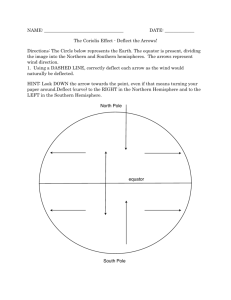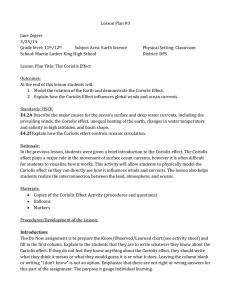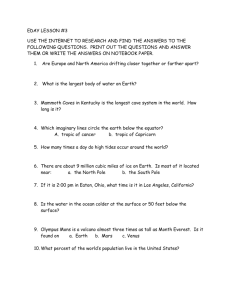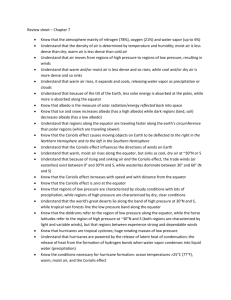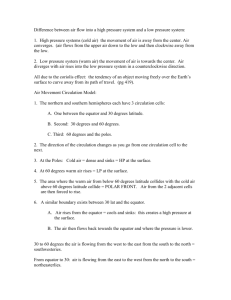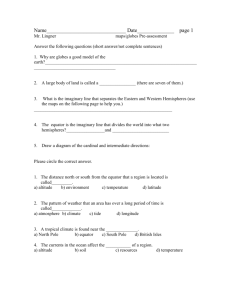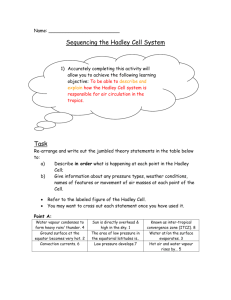Modeling the Coriolis Effect: Balloon Activity for High School
advertisement
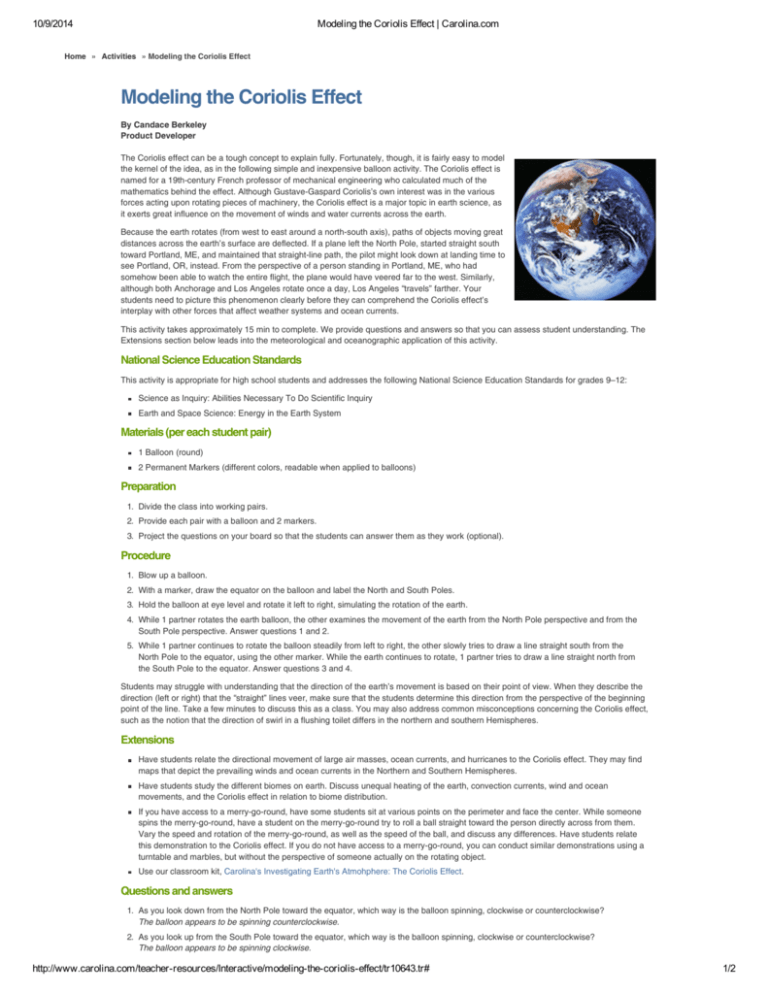
10/9/2014 Modeling the Coriolis Effect | Carolina.com Home » Activities » Modeling the Coriolis Effect Modeling the Coriolis Effect By Candace Berkeley Product Developer The Coriolis effect can be a tough concept to explain fully. Fortunately, though, it is fairly easy to model the kernel of the idea, as in the following simple and inexpensive balloon activity. The Coriolis effect is named for a 19th-century French professor of mechanical engineering who calculated much of the mathematics behind the effect. Although Gustave-Gaspard Coriolis’s own interest was in the various forces acting upon rotating pieces of machinery, the Coriolis effect is a major topic in earth science, as it exerts great influence on the movement of winds and water currents across the earth. Because the earth rotates (from west to east around a north-south axis), paths of objects moving great distances across the earth’s surface are deflected. If a plane left the North Pole, started straight south toward Portland, ME, and maintained that straight-line path, the pilot might look down at landing time to see Portland, OR, instead. From the perspective of a person standing in Portland, ME, who had somehow been able to watch the entire flight, the plane would have veered far to the west. Similarly, although both Anchorage and Los Angeles rotate once a day, Los Angeles “travels” farther. Your students need to picture this phenomenon clearly before they can comprehend the Coriolis effect’s interplay with other forces that affect weather systems and ocean currents. This activity takes approximately 15 min to complete. We provide questions and answers so that you can assess student understanding. The Extensions section below leads into the meteorological and oceanographic application of this activity. National Science Education Standards This activity is appropriate for high school students and addresses the following National Science Education Standards for grades 9–12: Science as Inquiry: Abilities Necessary To Do Scientific Inquiry Earth and Space Science: Energy in the Earth System Materials (per each student pair) 1 Balloon (round) 2 Permanent Markers (different colors, readable when applied to balloons) Preparation 1. Divide the class into working pairs. 2. Provide each pair with a balloon and 2 markers. 3. Project the questions on your board so that the students can answer them as they work (optional). Procedure 1. Blow up a balloon. 2. With a marker, draw the equator on the balloon and label the North and South Poles. 3. Hold the balloon at eye level and rotate it left to right, simulating the rotation of the earth. 4. While 1 partner rotates the earth balloon, the other examines the movement of the earth from the North Pole perspective and from the South Pole perspective. Answer questions 1 and 2. 5. While 1 partner continues to rotate the balloon steadily from left to right, the other slowly tries to draw a line straight south from the North Pole to the equator, using the other marker. While the earth continues to rotate, 1 partner tries to draw a line straight north from the South Pole to the equator. Answer questions 3 and 4. Students may struggle with understanding that the direction of the earth’s movement is based on their point of view. When they describe the direction (left or right) that the “straight” lines veer, make sure that the students determine this direction from the perspective of the beginning point of the line. Take a few minutes to discuss this as a class. You may also address common misconceptions concerning the Coriolis effect, such as the notion that the direction of swirl in a flushing toilet differs in the northern and southern Hemispheres. Extensions Have students relate the directional movement of large air masses, ocean currents, and hurricanes to the Coriolis effect. They may find maps that depict the prevailing winds and ocean currents in the Northern and Southern Hemispheres. Have students study the different biomes on earth. Discuss unequal heating of the earth, convection currents, wind and ocean movements, and the Coriolis effect in relation to biome distribution. If you have access to a merry-go-round, have some students sit at various points on the perimeter and face the center. While someone spins the merry-go-round, have a student on the merry-go-round try to roll a ball straight toward the person directly across from them. Vary the speed and rotation of the merry-go-round, as well as the speed of the ball, and discuss any differences. Have students relate this demonstration to the Coriolis effect. If you do not have access to a merry-go-round, you can conduct similar demonstrations using a turntable and marbles, but without the perspective of someone actually on the rotating object. Use our classroom kit, Carolina's Investigating Earth's Atmohphere: The Coriolis Effect. Questions and answers 1. As you look down from the North Pole toward the equator, which way is the balloon spinning, clockwise or counterclockwise? The balloon appears to be spinning counterclockwise. 2. As you look up from the South Pole toward the equator, which way is the balloon spinning, clockwise or counterclockwise? The balloon appears to be spinning clockwise. http://www.carolina.com/teacher-resources/Interactive/modeling-the-coriolis-effect/tr10643.tr# 1/2 10/9/2014 Modeling the Coriolis Effect | Carolina.com 3. What happened when you tried to draw a straight line from the North Pole to the equator? The line was not straight but instead veered west of the intended path (to the right, when examining the line from the North Pole to the equator). 4. What happened when you tried to draw a straight line from the South Pole to the equator? The line was not straight but instead veered west of the intended path (to the left, when examining the line from the South Pole to the equator). 5. Predict what would happen if you again drew lines in the Northern and Southern Hemispheres but with the earth rotating in the opposite direction. The curving of the objects in the Northern and Southern Hemispheres would be reversed. Objects moving from the North Pole to the equator would veer to the left of their path and objects moving from the South Pole toward the equator would veer to the right of their path (toward the east, in both cases). http://www.carolina.com/teacher-resources/Interactive/modeling-the-coriolis-effect/tr10643.tr# 2/2

